Strategic Business Report: Nike's Competitive Position and Planning
VerifiedAdded on 2023/06/17
|15
|4511
|82
Report
AI Summary
This report provides a comprehensive analysis of Nike's business strategy, examining both the internal and external factors that influence its competitive position. It utilizes the PESTEL framework to assess the macro-environmental factors, including political, economic, social, technological, environmental, and legal aspects, and analyzes their impact on Nike's operations. Furthermore, the report evaluates Nike's internal environment and capabilities through SWOT and VRIO analyses, identifying strengths, weaknesses, opportunities, and threats, as well as valuable, rare, inimitable, and organization-supported resources. Stakeholder analysis is also conducted to understand the interests of various stakeholders, including customers, communities, employees, and the government. The report concludes by discussing strategic planning and implementation for Nike, emphasizing the importance of innovation, sustainability, and ethical practices for long-term success.
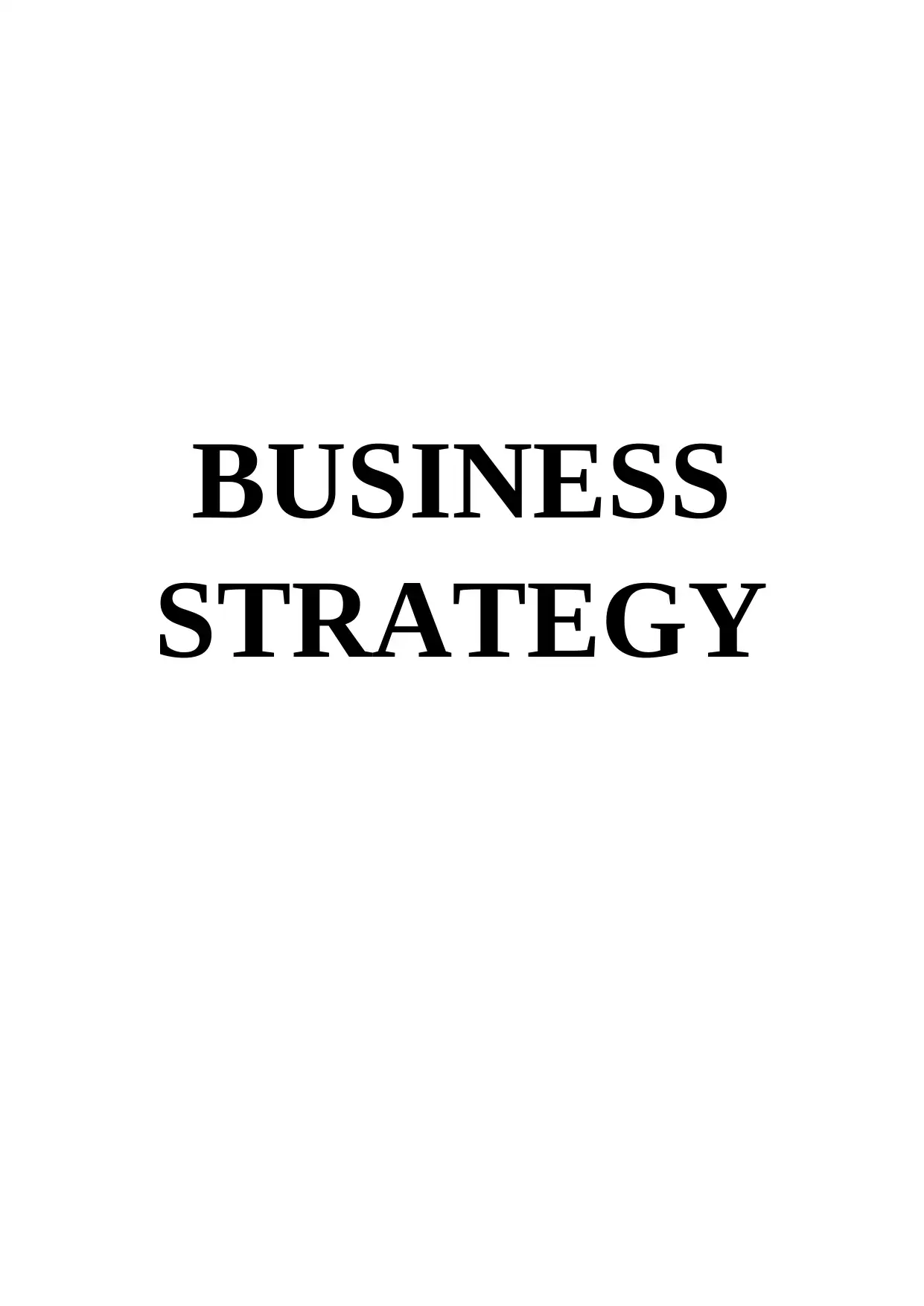
BUSINESS
STRATEGY
STRATEGY
Paraphrase This Document
Need a fresh take? Get an instant paraphrase of this document with our AI Paraphraser
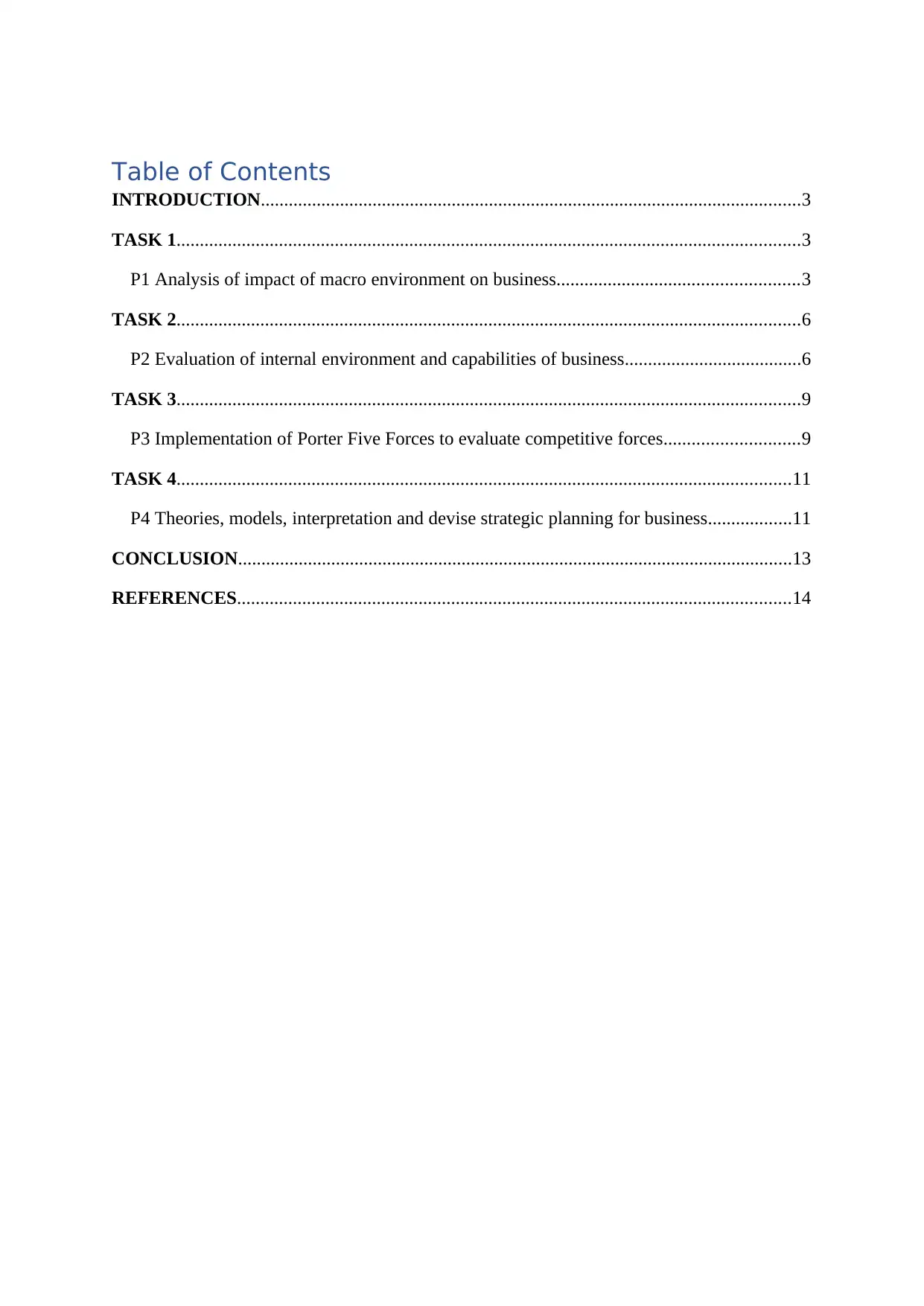
Table of Contents
INTRODUCTION....................................................................................................................3
TASK 1......................................................................................................................................3
P1 Analysis of impact of macro environment on business....................................................3
TASK 2......................................................................................................................................6
P2 Evaluation of internal environment and capabilities of business......................................6
TASK 3......................................................................................................................................9
P3 Implementation of Porter Five Forces to evaluate competitive forces.............................9
TASK 4....................................................................................................................................11
P4 Theories, models, interpretation and devise strategic planning for business..................11
CONCLUSION.......................................................................................................................13
REFERENCES.......................................................................................................................14
INTRODUCTION....................................................................................................................3
TASK 1......................................................................................................................................3
P1 Analysis of impact of macro environment on business....................................................3
TASK 2......................................................................................................................................6
P2 Evaluation of internal environment and capabilities of business......................................6
TASK 3......................................................................................................................................9
P3 Implementation of Porter Five Forces to evaluate competitive forces.............................9
TASK 4....................................................................................................................................11
P4 Theories, models, interpretation and devise strategic planning for business..................11
CONCLUSION.......................................................................................................................13
REFERENCES.......................................................................................................................14
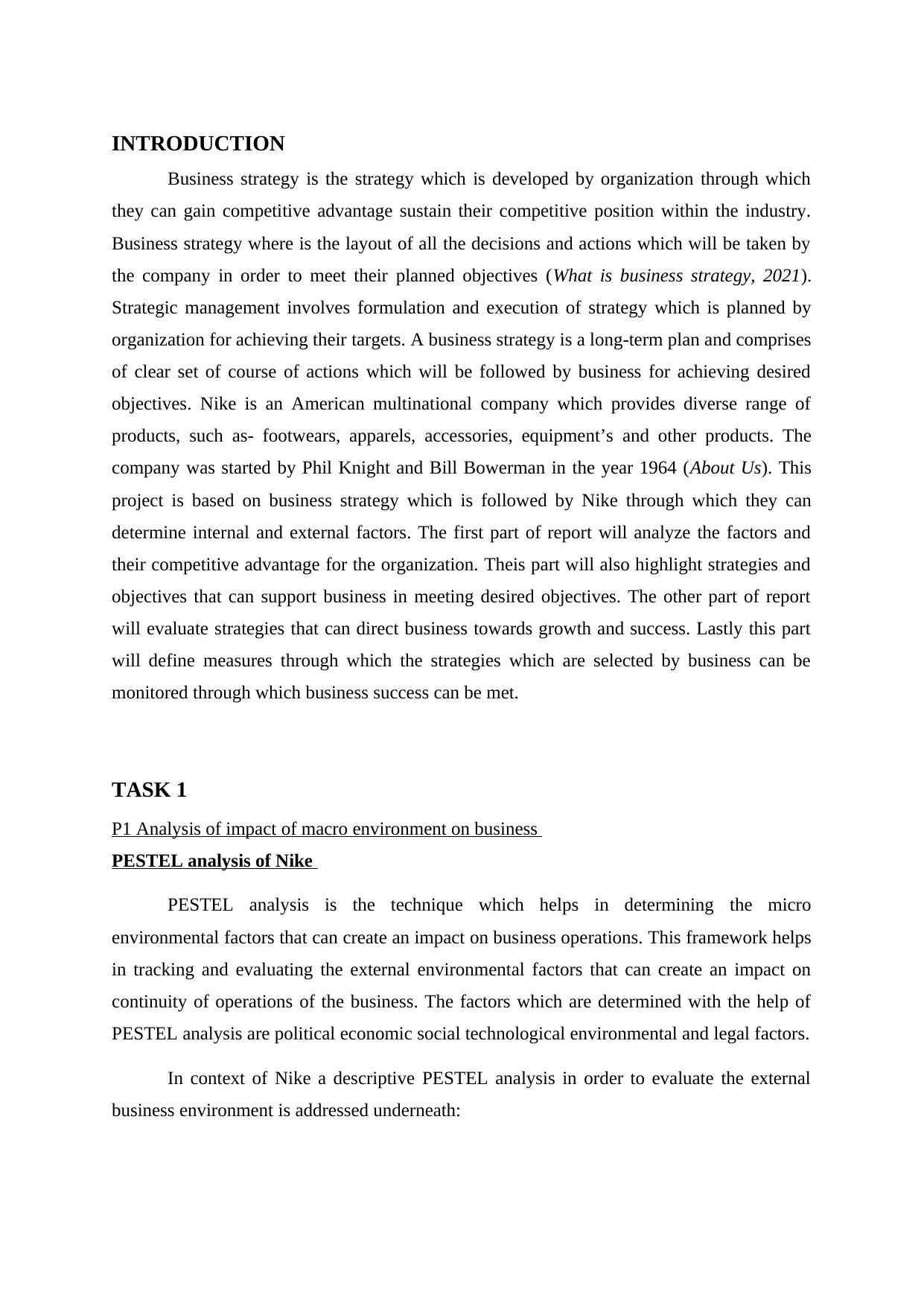
INTRODUCTION
Business strategy is the strategy which is developed by organization through which
they can gain competitive advantage sustain their competitive position within the industry.
Business strategy where is the layout of all the decisions and actions which will be taken by
the company in order to meet their planned objectives (What is business strategy, 2021).
Strategic management involves formulation and execution of strategy which is planned by
organization for achieving their targets. A business strategy is a long-term plan and comprises
of clear set of course of actions which will be followed by business for achieving desired
objectives. Nike is an American multinational company which provides diverse range of
products, such as- footwears, apparels, accessories, equipment’s and other products. The
company was started by Phil Knight and Bill Bowerman in the year 1964 (About Us). This
project is based on business strategy which is followed by Nike through which they can
determine internal and external factors. The first part of report will analyze the factors and
their competitive advantage for the organization. Theis part will also highlight strategies and
objectives that can support business in meeting desired objectives. The other part of report
will evaluate strategies that can direct business towards growth and success. Lastly this part
will define measures through which the strategies which are selected by business can be
monitored through which business success can be met.
TASK 1
P1 Analysis of impact of macro environment on business
PESTEL analysis of Nike
PESTEL analysis is the technique which helps in determining the micro
environmental factors that can create an impact on business operations. This framework helps
in tracking and evaluating the external environmental factors that can create an impact on
continuity of operations of the business. The factors which are determined with the help of
PESTEL analysis are political economic social technological environmental and legal factors.
In context of Nike a descriptive PESTEL analysis in order to evaluate the external
business environment is addressed underneath:
Business strategy is the strategy which is developed by organization through which
they can gain competitive advantage sustain their competitive position within the industry.
Business strategy where is the layout of all the decisions and actions which will be taken by
the company in order to meet their planned objectives (What is business strategy, 2021).
Strategic management involves formulation and execution of strategy which is planned by
organization for achieving their targets. A business strategy is a long-term plan and comprises
of clear set of course of actions which will be followed by business for achieving desired
objectives. Nike is an American multinational company which provides diverse range of
products, such as- footwears, apparels, accessories, equipment’s and other products. The
company was started by Phil Knight and Bill Bowerman in the year 1964 (About Us). This
project is based on business strategy which is followed by Nike through which they can
determine internal and external factors. The first part of report will analyze the factors and
their competitive advantage for the organization. Theis part will also highlight strategies and
objectives that can support business in meeting desired objectives. The other part of report
will evaluate strategies that can direct business towards growth and success. Lastly this part
will define measures through which the strategies which are selected by business can be
monitored through which business success can be met.
TASK 1
P1 Analysis of impact of macro environment on business
PESTEL analysis of Nike
PESTEL analysis is the technique which helps in determining the micro
environmental factors that can create an impact on business operations. This framework helps
in tracking and evaluating the external environmental factors that can create an impact on
continuity of operations of the business. The factors which are determined with the help of
PESTEL analysis are political economic social technological environmental and legal factors.
In context of Nike a descriptive PESTEL analysis in order to evaluate the external
business environment is addressed underneath:
You're viewing a preview
Unlock full access by subscribing today!
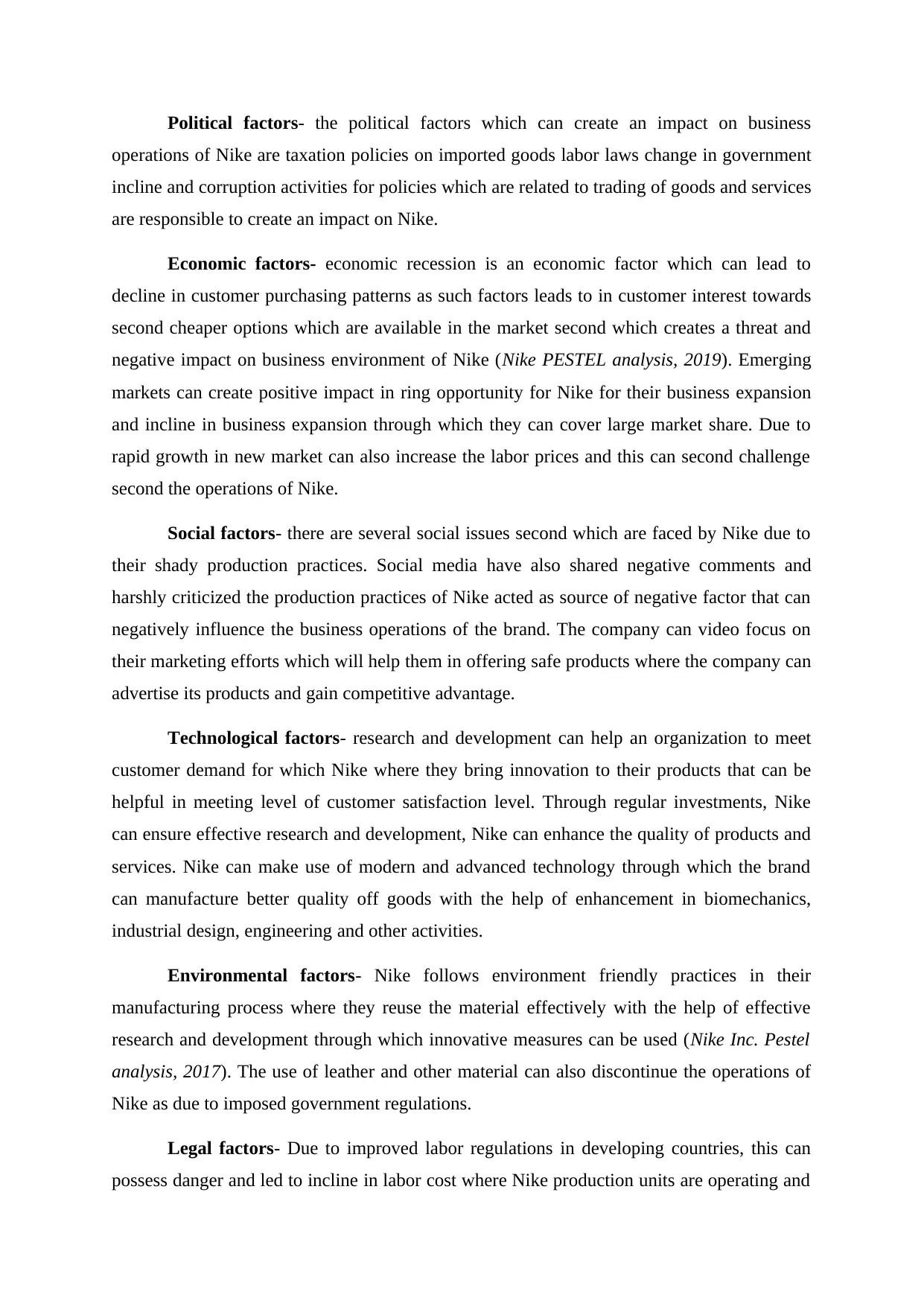
Political factors- the political factors which can create an impact on business
operations of Nike are taxation policies on imported goods labor laws change in government
incline and corruption activities for policies which are related to trading of goods and services
are responsible to create an impact on Nike.
Economic factors- economic recession is an economic factor which can lead to
decline in customer purchasing patterns as such factors leads to in customer interest towards
second cheaper options which are available in the market second which creates a threat and
negative impact on business environment of Nike (Nike PESTEL analysis, 2019). Emerging
markets can create positive impact in ring opportunity for Nike for their business expansion
and incline in business expansion through which they can cover large market share. Due to
rapid growth in new market can also increase the labor prices and this can second challenge
second the operations of Nike.
Social factors- there are several social issues second which are faced by Nike due to
their shady production practices. Social media have also shared negative comments and
harshly criticized the production practices of Nike acted as source of negative factor that can
negatively influence the business operations of the brand. The company can video focus on
their marketing efforts which will help them in offering safe products where the company can
advertise its products and gain competitive advantage.
Technological factors- research and development can help an organization to meet
customer demand for which Nike where they bring innovation to their products that can be
helpful in meeting level of customer satisfaction level. Through regular investments, Nike
can ensure effective research and development, Nike can enhance the quality of products and
services. Nike can make use of modern and advanced technology through which the brand
can manufacture better quality off goods with the help of enhancement in biomechanics,
industrial design, engineering and other activities.
Environmental factors- Nike follows environment friendly practices in their
manufacturing process where they reuse the material effectively with the help of effective
research and development through which innovative measures can be used (Nike Inc. Pestel
analysis, 2017). The use of leather and other material can also discontinue the operations of
Nike as due to imposed government regulations.
Legal factors- Due to improved labor regulations in developing countries, this can
possess danger and led to incline in labor cost where Nike production units are operating and
operations of Nike are taxation policies on imported goods labor laws change in government
incline and corruption activities for policies which are related to trading of goods and services
are responsible to create an impact on Nike.
Economic factors- economic recession is an economic factor which can lead to
decline in customer purchasing patterns as such factors leads to in customer interest towards
second cheaper options which are available in the market second which creates a threat and
negative impact on business environment of Nike (Nike PESTEL analysis, 2019). Emerging
markets can create positive impact in ring opportunity for Nike for their business expansion
and incline in business expansion through which they can cover large market share. Due to
rapid growth in new market can also increase the labor prices and this can second challenge
second the operations of Nike.
Social factors- there are several social issues second which are faced by Nike due to
their shady production practices. Social media have also shared negative comments and
harshly criticized the production practices of Nike acted as source of negative factor that can
negatively influence the business operations of the brand. The company can video focus on
their marketing efforts which will help them in offering safe products where the company can
advertise its products and gain competitive advantage.
Technological factors- research and development can help an organization to meet
customer demand for which Nike where they bring innovation to their products that can be
helpful in meeting level of customer satisfaction level. Through regular investments, Nike
can ensure effective research and development, Nike can enhance the quality of products and
services. Nike can make use of modern and advanced technology through which the brand
can manufacture better quality off goods with the help of enhancement in biomechanics,
industrial design, engineering and other activities.
Environmental factors- Nike follows environment friendly practices in their
manufacturing process where they reuse the material effectively with the help of effective
research and development through which innovative measures can be used (Nike Inc. Pestel
analysis, 2017). The use of leather and other material can also discontinue the operations of
Nike as due to imposed government regulations.
Legal factors- Due to improved labor regulations in developing countries, this can
possess danger and led to incline in labor cost where Nike production units are operating and
Paraphrase This Document
Need a fresh take? Get an instant paraphrase of this document with our AI Paraphraser
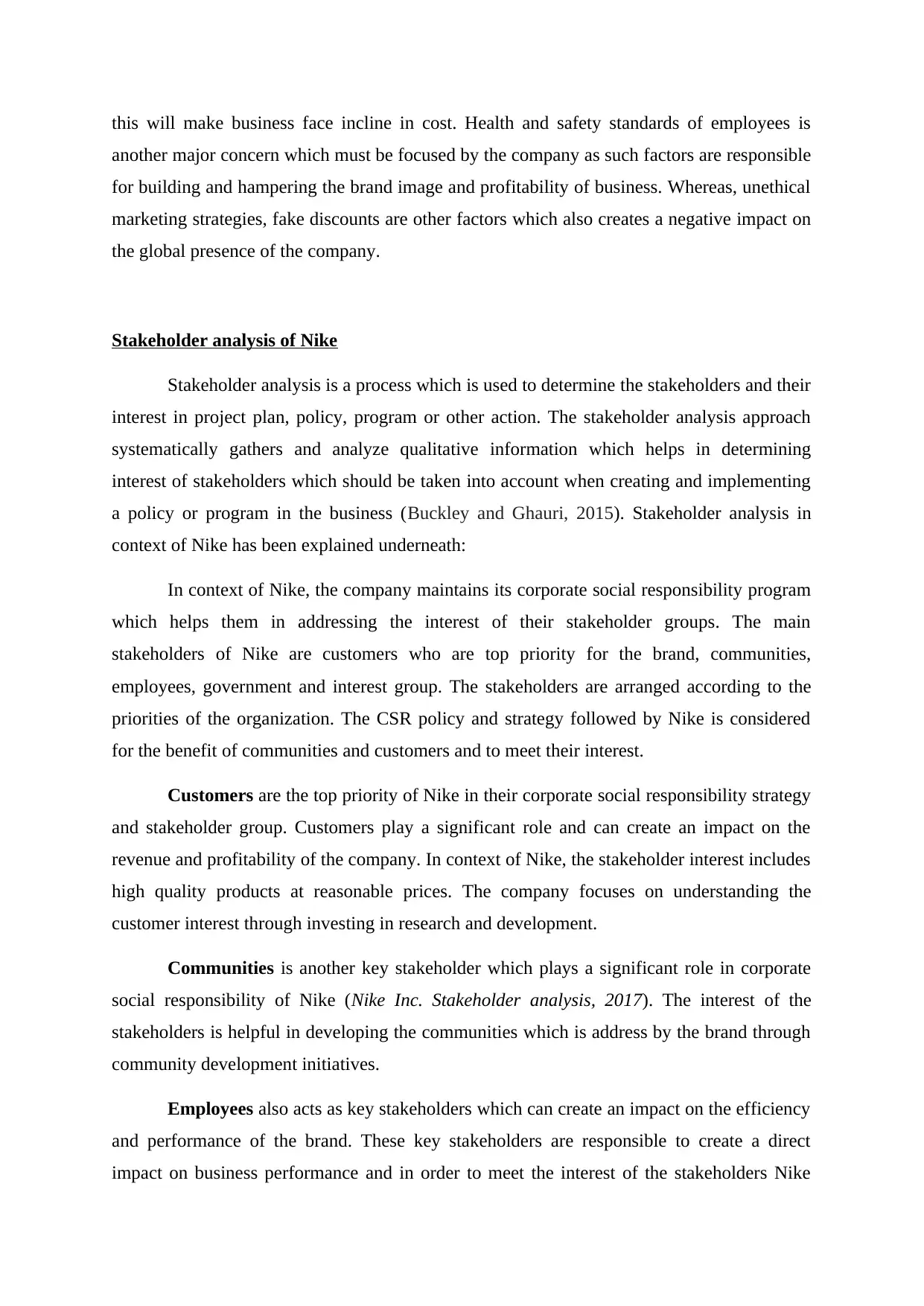
this will make business face incline in cost. Health and safety standards of employees is
another major concern which must be focused by the company as such factors are responsible
for building and hampering the brand image and profitability of business. Whereas, unethical
marketing strategies, fake discounts are other factors which also creates a negative impact on
the global presence of the company.
Stakeholder analysis of Nike
Stakeholder analysis is a process which is used to determine the stakeholders and their
interest in project plan, policy, program or other action. The stakeholder analysis approach
systematically gathers and analyze qualitative information which helps in determining
interest of stakeholders which should be taken into account when creating and implementing
a policy or program in the business (Buckley and Ghauri, 2015). Stakeholder analysis in
context of Nike has been explained underneath:
In context of Nike, the company maintains its corporate social responsibility program
which helps them in addressing the interest of their stakeholder groups. The main
stakeholders of Nike are customers who are top priority for the brand, communities,
employees, government and interest group. The stakeholders are arranged according to the
priorities of the organization. The CSR policy and strategy followed by Nike is considered
for the benefit of communities and customers and to meet their interest.
Customers are the top priority of Nike in their corporate social responsibility strategy
and stakeholder group. Customers play a significant role and can create an impact on the
revenue and profitability of the company. In context of Nike, the stakeholder interest includes
high quality products at reasonable prices. The company focuses on understanding the
customer interest through investing in research and development.
Communities is another key stakeholder which plays a significant role in corporate
social responsibility of Nike (Nike Inc. Stakeholder analysis, 2017). The interest of the
stakeholders is helpful in developing the communities which is address by the brand through
community development initiatives.
Employees also acts as key stakeholders which can create an impact on the efficiency
and performance of the brand. These key stakeholders are responsible to create a direct
impact on business performance and in order to meet the interest of the stakeholders Nike
another major concern which must be focused by the company as such factors are responsible
for building and hampering the brand image and profitability of business. Whereas, unethical
marketing strategies, fake discounts are other factors which also creates a negative impact on
the global presence of the company.
Stakeholder analysis of Nike
Stakeholder analysis is a process which is used to determine the stakeholders and their
interest in project plan, policy, program or other action. The stakeholder analysis approach
systematically gathers and analyze qualitative information which helps in determining
interest of stakeholders which should be taken into account when creating and implementing
a policy or program in the business (Buckley and Ghauri, 2015). Stakeholder analysis in
context of Nike has been explained underneath:
In context of Nike, the company maintains its corporate social responsibility program
which helps them in addressing the interest of their stakeholder groups. The main
stakeholders of Nike are customers who are top priority for the brand, communities,
employees, government and interest group. The stakeholders are arranged according to the
priorities of the organization. The CSR policy and strategy followed by Nike is considered
for the benefit of communities and customers and to meet their interest.
Customers are the top priority of Nike in their corporate social responsibility strategy
and stakeholder group. Customers play a significant role and can create an impact on the
revenue and profitability of the company. In context of Nike, the stakeholder interest includes
high quality products at reasonable prices. The company focuses on understanding the
customer interest through investing in research and development.
Communities is another key stakeholder which plays a significant role in corporate
social responsibility of Nike (Nike Inc. Stakeholder analysis, 2017). The interest of the
stakeholders is helpful in developing the communities which is address by the brand through
community development initiatives.
Employees also acts as key stakeholders which can create an impact on the efficiency
and performance of the brand. These key stakeholders are responsible to create a direct
impact on business performance and in order to meet the interest of the stakeholders Nike
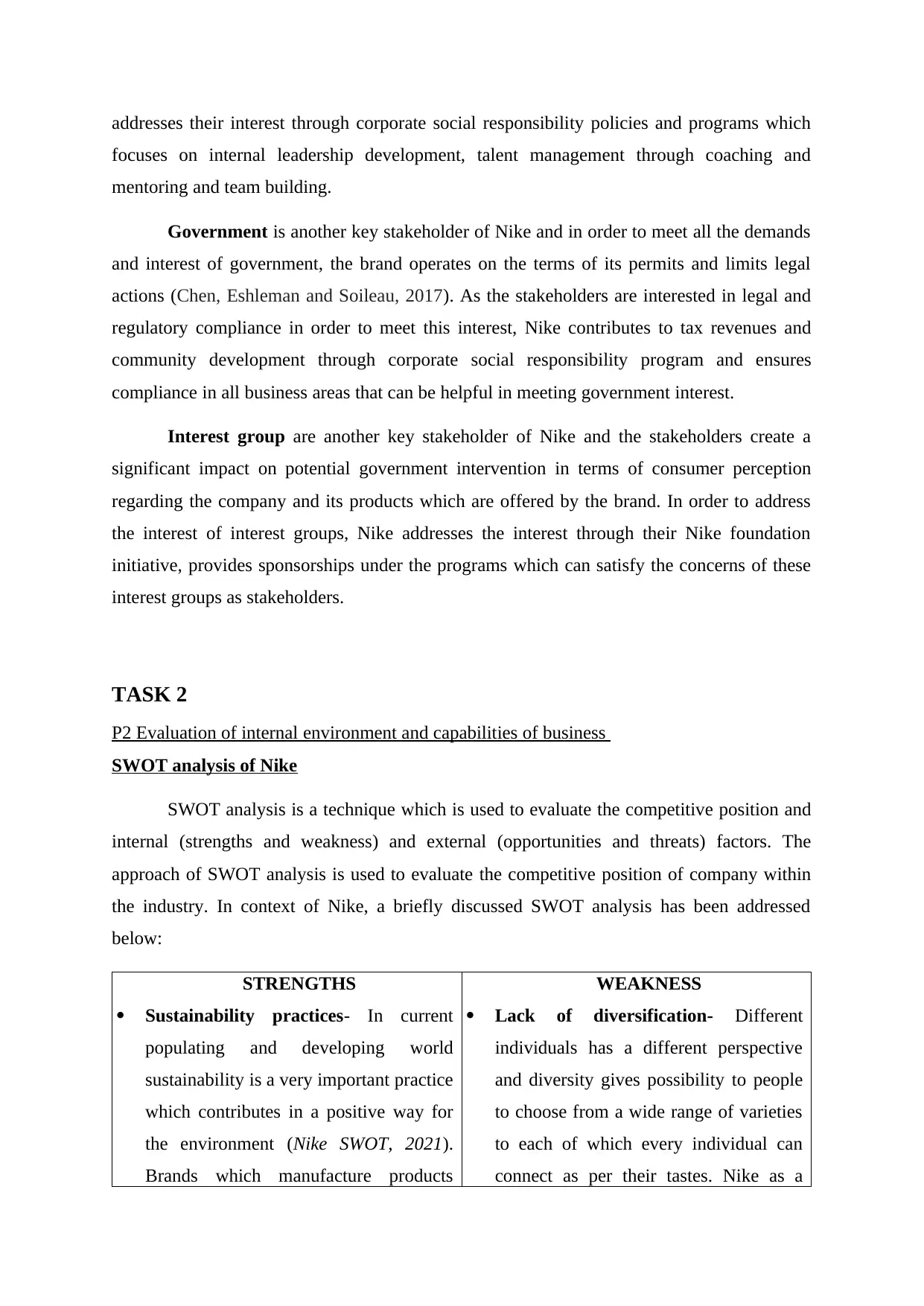
addresses their interest through corporate social responsibility policies and programs which
focuses on internal leadership development, talent management through coaching and
mentoring and team building.
Government is another key stakeholder of Nike and in order to meet all the demands
and interest of government, the brand operates on the terms of its permits and limits legal
actions (Chen, Eshleman and Soileau, 2017). As the stakeholders are interested in legal and
regulatory compliance in order to meet this interest, Nike contributes to tax revenues and
community development through corporate social responsibility program and ensures
compliance in all business areas that can be helpful in meeting government interest.
Interest group are another key stakeholder of Nike and the stakeholders create a
significant impact on potential government intervention in terms of consumer perception
regarding the company and its products which are offered by the brand. In order to address
the interest of interest groups, Nike addresses the interest through their Nike foundation
initiative, provides sponsorships under the programs which can satisfy the concerns of these
interest groups as stakeholders.
TASK 2
P2 Evaluation of internal environment and capabilities of business
SWOT analysis of Nike
SWOT analysis is a technique which is used to evaluate the competitive position and
internal (strengths and weakness) and external (opportunities and threats) factors. The
approach of SWOT analysis is used to evaluate the competitive position of company within
the industry. In context of Nike, a briefly discussed SWOT analysis has been addressed
below:
STRENGTHS
Sustainability practices- In current
populating and developing world
sustainability is a very important practice
which contributes in a positive way for
the environment (Nike SWOT, 2021).
Brands which manufacture products
WEAKNESS
Lack of diversification- Different
individuals has a different perspective
and diversity gives possibility to people
to choose from a wide range of varieties
to each of which every individual can
connect as per their tastes. Nike as a
focuses on internal leadership development, talent management through coaching and
mentoring and team building.
Government is another key stakeholder of Nike and in order to meet all the demands
and interest of government, the brand operates on the terms of its permits and limits legal
actions (Chen, Eshleman and Soileau, 2017). As the stakeholders are interested in legal and
regulatory compliance in order to meet this interest, Nike contributes to tax revenues and
community development through corporate social responsibility program and ensures
compliance in all business areas that can be helpful in meeting government interest.
Interest group are another key stakeholder of Nike and the stakeholders create a
significant impact on potential government intervention in terms of consumer perception
regarding the company and its products which are offered by the brand. In order to address
the interest of interest groups, Nike addresses the interest through their Nike foundation
initiative, provides sponsorships under the programs which can satisfy the concerns of these
interest groups as stakeholders.
TASK 2
P2 Evaluation of internal environment and capabilities of business
SWOT analysis of Nike
SWOT analysis is a technique which is used to evaluate the competitive position and
internal (strengths and weakness) and external (opportunities and threats) factors. The
approach of SWOT analysis is used to evaluate the competitive position of company within
the industry. In context of Nike, a briefly discussed SWOT analysis has been addressed
below:
STRENGTHS
Sustainability practices- In current
populating and developing world
sustainability is a very important practice
which contributes in a positive way for
the environment (Nike SWOT, 2021).
Brands which manufacture products
WEAKNESS
Lack of diversification- Different
individuals has a different perspective
and diversity gives possibility to people
to choose from a wide range of varieties
to each of which every individual can
connect as per their tastes. Nike as a
You're viewing a preview
Unlock full access by subscribing today!
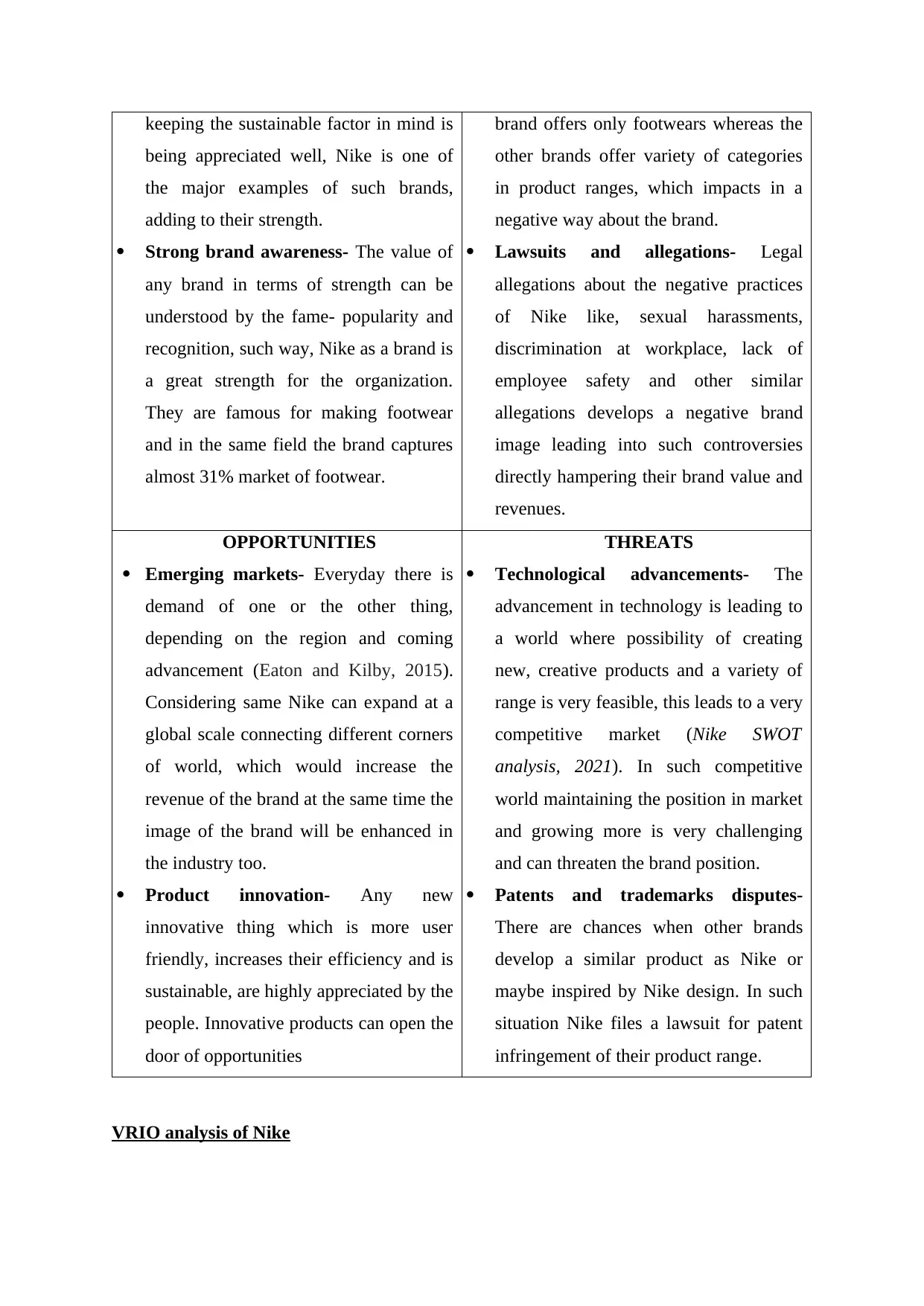
keeping the sustainable factor in mind is
being appreciated well, Nike is one of
the major examples of such brands,
adding to their strength.
Strong brand awareness- The value of
any brand in terms of strength can be
understood by the fame- popularity and
recognition, such way, Nike as a brand is
a great strength for the organization.
They are famous for making footwear
and in the same field the brand captures
almost 31% market of footwear.
brand offers only footwears whereas the
other brands offer variety of categories
in product ranges, which impacts in a
negative way about the brand.
Lawsuits and allegations- Legal
allegations about the negative practices
of Nike like, sexual harassments,
discrimination at workplace, lack of
employee safety and other similar
allegations develops a negative brand
image leading into such controversies
directly hampering their brand value and
revenues.
OPPORTUNITIES
Emerging markets- Everyday there is
demand of one or the other thing,
depending on the region and coming
advancement (Eaton and Kilby, 2015).
Considering same Nike can expand at a
global scale connecting different corners
of world, which would increase the
revenue of the brand at the same time the
image of the brand will be enhanced in
the industry too.
Product innovation- Any new
innovative thing which is more user
friendly, increases their efficiency and is
sustainable, are highly appreciated by the
people. Innovative products can open the
door of opportunities
THREATS
Technological advancements- The
advancement in technology is leading to
a world where possibility of creating
new, creative products and a variety of
range is very feasible, this leads to a very
competitive market (Nike SWOT
analysis, 2021). In such competitive
world maintaining the position in market
and growing more is very challenging
and can threaten the brand position.
Patents and trademarks disputes-
There are chances when other brands
develop a similar product as Nike or
maybe inspired by Nike design. In such
situation Nike files a lawsuit for patent
infringement of their product range.
VRIO analysis of Nike
being appreciated well, Nike is one of
the major examples of such brands,
adding to their strength.
Strong brand awareness- The value of
any brand in terms of strength can be
understood by the fame- popularity and
recognition, such way, Nike as a brand is
a great strength for the organization.
They are famous for making footwear
and in the same field the brand captures
almost 31% market of footwear.
brand offers only footwears whereas the
other brands offer variety of categories
in product ranges, which impacts in a
negative way about the brand.
Lawsuits and allegations- Legal
allegations about the negative practices
of Nike like, sexual harassments,
discrimination at workplace, lack of
employee safety and other similar
allegations develops a negative brand
image leading into such controversies
directly hampering their brand value and
revenues.
OPPORTUNITIES
Emerging markets- Everyday there is
demand of one or the other thing,
depending on the region and coming
advancement (Eaton and Kilby, 2015).
Considering same Nike can expand at a
global scale connecting different corners
of world, which would increase the
revenue of the brand at the same time the
image of the brand will be enhanced in
the industry too.
Product innovation- Any new
innovative thing which is more user
friendly, increases their efficiency and is
sustainable, are highly appreciated by the
people. Innovative products can open the
door of opportunities
THREATS
Technological advancements- The
advancement in technology is leading to
a world where possibility of creating
new, creative products and a variety of
range is very feasible, this leads to a very
competitive market (Nike SWOT
analysis, 2021). In such competitive
world maintaining the position in market
and growing more is very challenging
and can threaten the brand position.
Patents and trademarks disputes-
There are chances when other brands
develop a similar product as Nike or
maybe inspired by Nike design. In such
situation Nike files a lawsuit for patent
infringement of their product range.
VRIO analysis of Nike
Paraphrase This Document
Need a fresh take? Get an instant paraphrase of this document with our AI Paraphraser
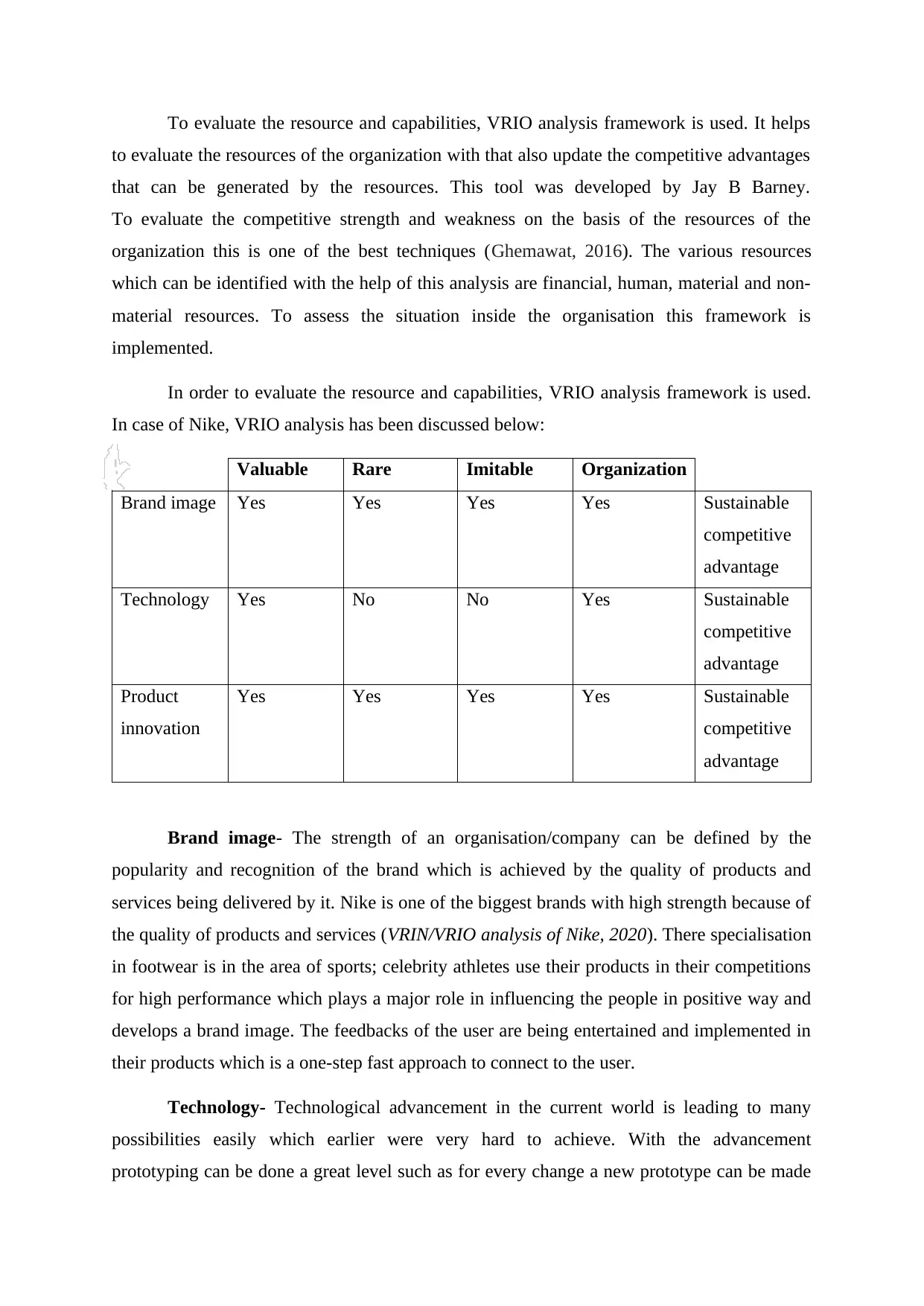
To evaluate the resource and capabilities, VRIO analysis framework is used. It helps
to evaluate the resources of the organization with that also update the competitive advantages
that can be generated by the resources. This tool was developed by Jay B Barney.
To evaluate the competitive strength and weakness on the basis of the resources of the
organization this is one of the best techniques (Ghemawat, 2016). The various resources
which can be identified with the help of this analysis are financial, human, material and non-
material resources. To assess the situation inside the organisation this framework is
implemented.
In order to evaluate the resource and capabilities, VRIO analysis framework is used.
In case of Nike, VRIO analysis has been discussed below:
Valuable Rare Imitable Organization
Brand image Yes Yes Yes Yes Sustainable
competitive
advantage
Technology Yes No No Yes Sustainable
competitive
advantage
Product
innovation
Yes Yes Yes Yes Sustainable
competitive
advantage
Brand image- The strength of an organisation/company can be defined by the
popularity and recognition of the brand which is achieved by the quality of products and
services being delivered by it. Nike is one of the biggest brands with high strength because of
the quality of products and services (VRIN/VRIO analysis of Nike, 2020). There specialisation
in footwear is in the area of sports; celebrity athletes use their products in their competitions
for high performance which plays a major role in influencing the people in positive way and
develops a brand image. The feedbacks of the user are being entertained and implemented in
their products which is a one-step fast approach to connect to the user.
Technology- Technological advancement in the current world is leading to many
possibilities easily which earlier were very hard to achieve. With the advancement
prototyping can be done a great level such as for every change a new prototype can be made
to evaluate the resources of the organization with that also update the competitive advantages
that can be generated by the resources. This tool was developed by Jay B Barney.
To evaluate the competitive strength and weakness on the basis of the resources of the
organization this is one of the best techniques (Ghemawat, 2016). The various resources
which can be identified with the help of this analysis are financial, human, material and non-
material resources. To assess the situation inside the organisation this framework is
implemented.
In order to evaluate the resource and capabilities, VRIO analysis framework is used.
In case of Nike, VRIO analysis has been discussed below:
Valuable Rare Imitable Organization
Brand image Yes Yes Yes Yes Sustainable
competitive
advantage
Technology Yes No No Yes Sustainable
competitive
advantage
Product
innovation
Yes Yes Yes Yes Sustainable
competitive
advantage
Brand image- The strength of an organisation/company can be defined by the
popularity and recognition of the brand which is achieved by the quality of products and
services being delivered by it. Nike is one of the biggest brands with high strength because of
the quality of products and services (VRIN/VRIO analysis of Nike, 2020). There specialisation
in footwear is in the area of sports; celebrity athletes use their products in their competitions
for high performance which plays a major role in influencing the people in positive way and
develops a brand image. The feedbacks of the user are being entertained and implemented in
their products which is a one-step fast approach to connect to the user.
Technology- Technological advancement in the current world is leading to many
possibilities easily which earlier were very hard to achieve. With the advancement
prototyping can be done a great level such as for every change a new prototype can be made
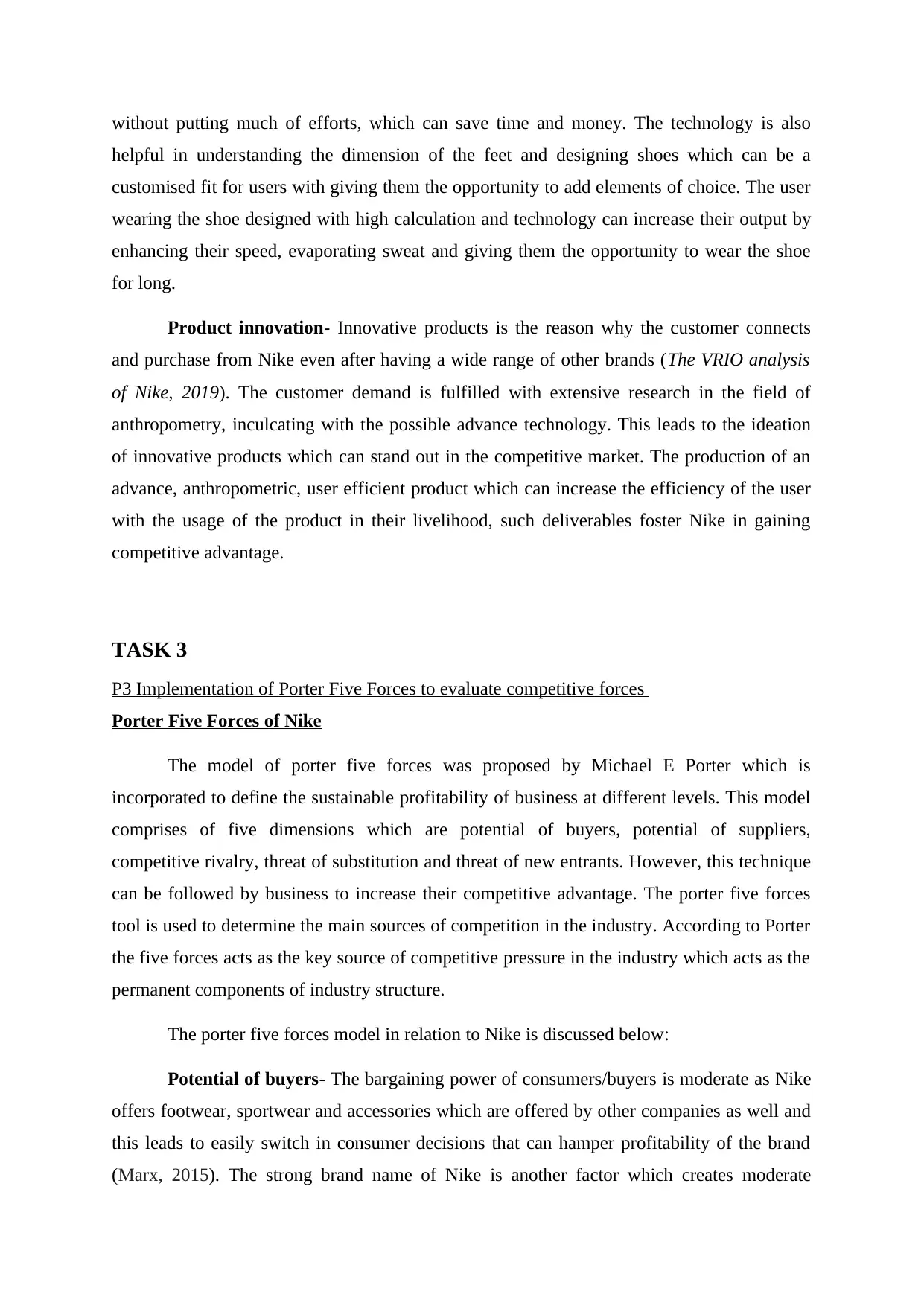
without putting much of efforts, which can save time and money. The technology is also
helpful in understanding the dimension of the feet and designing shoes which can be a
customised fit for users with giving them the opportunity to add elements of choice. The user
wearing the shoe designed with high calculation and technology can increase their output by
enhancing their speed, evaporating sweat and giving them the opportunity to wear the shoe
for long.
Product innovation- Innovative products is the reason why the customer connects
and purchase from Nike even after having a wide range of other brands (The VRIO analysis
of Nike, 2019). The customer demand is fulfilled with extensive research in the field of
anthropometry, inculcating with the possible advance technology. This leads to the ideation
of innovative products which can stand out in the competitive market. The production of an
advance, anthropometric, user efficient product which can increase the efficiency of the user
with the usage of the product in their livelihood, such deliverables foster Nike in gaining
competitive advantage.
TASK 3
P3 Implementation of Porter Five Forces to evaluate competitive forces
Porter Five Forces of Nike
The model of porter five forces was proposed by Michael E Porter which is
incorporated to define the sustainable profitability of business at different levels. This model
comprises of five dimensions which are potential of buyers, potential of suppliers,
competitive rivalry, threat of substitution and threat of new entrants. However, this technique
can be followed by business to increase their competitive advantage. The porter five forces
tool is used to determine the main sources of competition in the industry. According to Porter
the five forces acts as the key source of competitive pressure in the industry which acts as the
permanent components of industry structure.
The porter five forces model in relation to Nike is discussed below:
Potential of buyers- The bargaining power of consumers/buyers is moderate as Nike
offers footwear, sportwear and accessories which are offered by other companies as well and
this leads to easily switch in consumer decisions that can hamper profitability of the brand
(Marx, 2015). The strong brand name of Nike is another factor which creates moderate
helpful in understanding the dimension of the feet and designing shoes which can be a
customised fit for users with giving them the opportunity to add elements of choice. The user
wearing the shoe designed with high calculation and technology can increase their output by
enhancing their speed, evaporating sweat and giving them the opportunity to wear the shoe
for long.
Product innovation- Innovative products is the reason why the customer connects
and purchase from Nike even after having a wide range of other brands (The VRIO analysis
of Nike, 2019). The customer demand is fulfilled with extensive research in the field of
anthropometry, inculcating with the possible advance technology. This leads to the ideation
of innovative products which can stand out in the competitive market. The production of an
advance, anthropometric, user efficient product which can increase the efficiency of the user
with the usage of the product in their livelihood, such deliverables foster Nike in gaining
competitive advantage.
TASK 3
P3 Implementation of Porter Five Forces to evaluate competitive forces
Porter Five Forces of Nike
The model of porter five forces was proposed by Michael E Porter which is
incorporated to define the sustainable profitability of business at different levels. This model
comprises of five dimensions which are potential of buyers, potential of suppliers,
competitive rivalry, threat of substitution and threat of new entrants. However, this technique
can be followed by business to increase their competitive advantage. The porter five forces
tool is used to determine the main sources of competition in the industry. According to Porter
the five forces acts as the key source of competitive pressure in the industry which acts as the
permanent components of industry structure.
The porter five forces model in relation to Nike is discussed below:
Potential of buyers- The bargaining power of consumers/buyers is moderate as Nike
offers footwear, sportwear and accessories which are offered by other companies as well and
this leads to easily switch in consumer decisions that can hamper profitability of the brand
(Marx, 2015). The strong brand name of Nike is another factor which creates moderate
You're viewing a preview
Unlock full access by subscribing today!
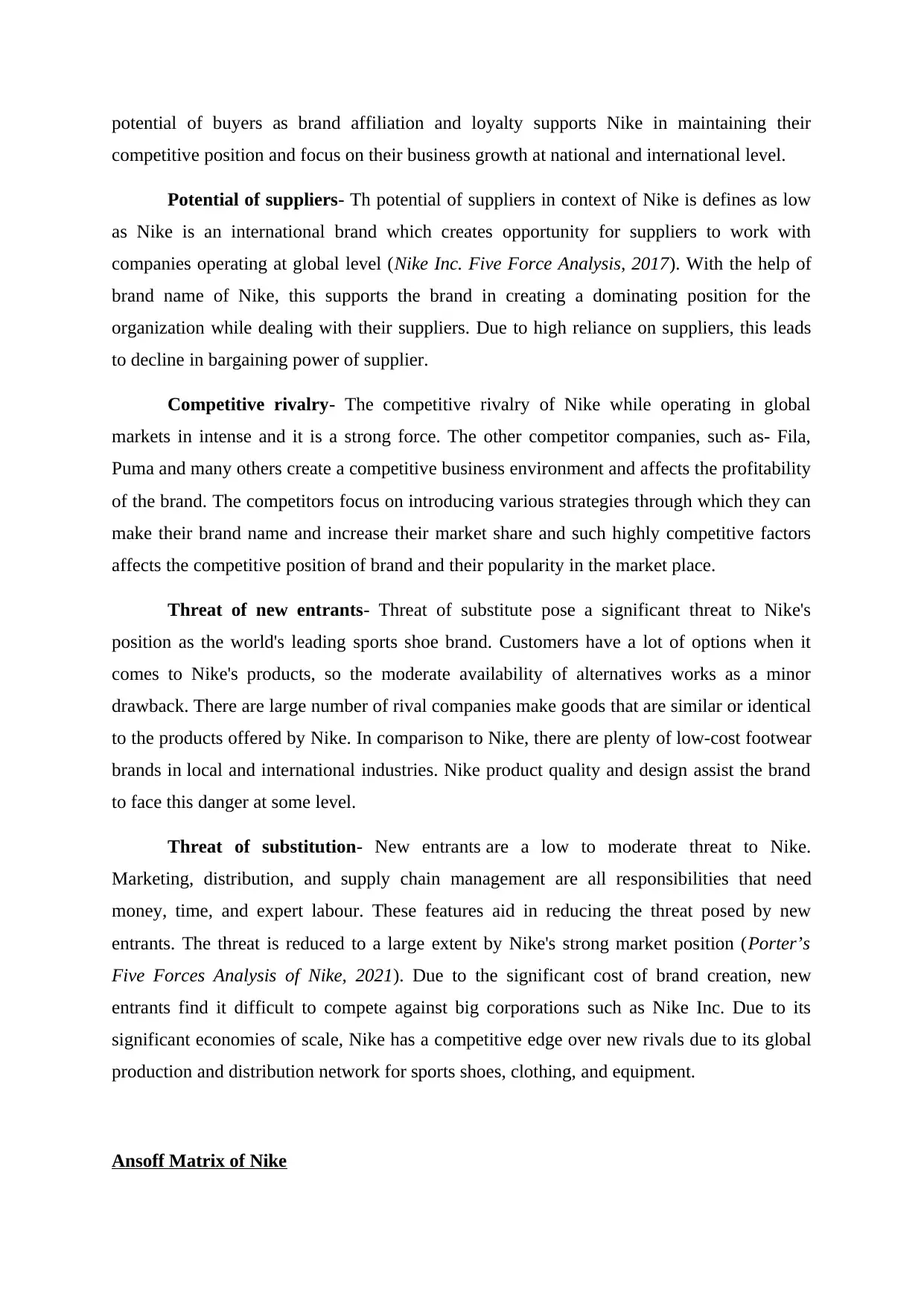
potential of buyers as brand affiliation and loyalty supports Nike in maintaining their
competitive position and focus on their business growth at national and international level.
Potential of suppliers- Th potential of suppliers in context of Nike is defines as low
as Nike is an international brand which creates opportunity for suppliers to work with
companies operating at global level (Nike Inc. Five Force Analysis, 2017). With the help of
brand name of Nike, this supports the brand in creating a dominating position for the
organization while dealing with their suppliers. Due to high reliance on suppliers, this leads
to decline in bargaining power of supplier.
Competitive rivalry- The competitive rivalry of Nike while operating in global
markets in intense and it is a strong force. The other competitor companies, such as- Fila,
Puma and many others create a competitive business environment and affects the profitability
of the brand. The competitors focus on introducing various strategies through which they can
make their brand name and increase their market share and such highly competitive factors
affects the competitive position of brand and their popularity in the market place.
Threat of new entrants- Threat of substitute pose a significant threat to Nike's
position as the world's leading sports shoe brand. Customers have a lot of options when it
comes to Nike's products, so the moderate availability of alternatives works as a minor
drawback. There are large number of rival companies make goods that are similar or identical
to the products offered by Nike. In comparison to Nike, there are plenty of low-cost footwear
brands in local and international industries. Nike product quality and design assist the brand
to face this danger at some level.
Threat of substitution- New entrants are a low to moderate threat to Nike.
Marketing, distribution, and supply chain management are all responsibilities that need
money, time, and expert labour. These features aid in reducing the threat posed by new
entrants. The threat is reduced to a large extent by Nike's strong market position (Porter’s
Five Forces Analysis of Nike, 2021). Due to the significant cost of brand creation, new
entrants find it difficult to compete against big corporations such as Nike Inc. Due to its
significant economies of scale, Nike has a competitive edge over new rivals due to its global
production and distribution network for sports shoes, clothing, and equipment.
Ansoff Matrix of Nike
competitive position and focus on their business growth at national and international level.
Potential of suppliers- Th potential of suppliers in context of Nike is defines as low
as Nike is an international brand which creates opportunity for suppliers to work with
companies operating at global level (Nike Inc. Five Force Analysis, 2017). With the help of
brand name of Nike, this supports the brand in creating a dominating position for the
organization while dealing with their suppliers. Due to high reliance on suppliers, this leads
to decline in bargaining power of supplier.
Competitive rivalry- The competitive rivalry of Nike while operating in global
markets in intense and it is a strong force. The other competitor companies, such as- Fila,
Puma and many others create a competitive business environment and affects the profitability
of the brand. The competitors focus on introducing various strategies through which they can
make their brand name and increase their market share and such highly competitive factors
affects the competitive position of brand and their popularity in the market place.
Threat of new entrants- Threat of substitute pose a significant threat to Nike's
position as the world's leading sports shoe brand. Customers have a lot of options when it
comes to Nike's products, so the moderate availability of alternatives works as a minor
drawback. There are large number of rival companies make goods that are similar or identical
to the products offered by Nike. In comparison to Nike, there are plenty of low-cost footwear
brands in local and international industries. Nike product quality and design assist the brand
to face this danger at some level.
Threat of substitution- New entrants are a low to moderate threat to Nike.
Marketing, distribution, and supply chain management are all responsibilities that need
money, time, and expert labour. These features aid in reducing the threat posed by new
entrants. The threat is reduced to a large extent by Nike's strong market position (Porter’s
Five Forces Analysis of Nike, 2021). Due to the significant cost of brand creation, new
entrants find it difficult to compete against big corporations such as Nike Inc. Due to its
significant economies of scale, Nike has a competitive edge over new rivals due to its global
production and distribution network for sports shoes, clothing, and equipment.
Ansoff Matrix of Nike
Paraphrase This Document
Need a fresh take? Get an instant paraphrase of this document with our AI Paraphraser
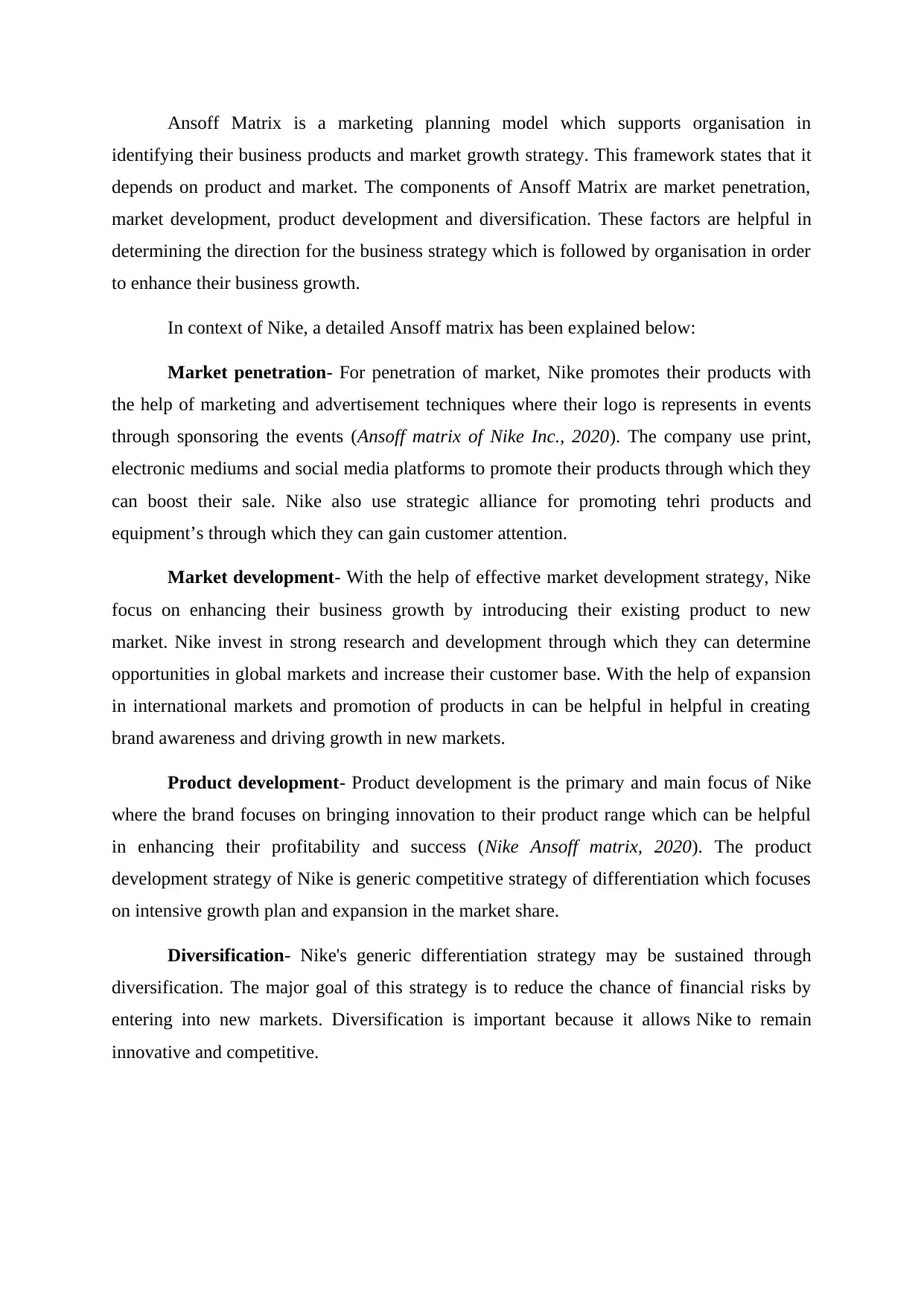
Ansoff Matrix is a marketing planning model which supports organisation in
identifying their business products and market growth strategy. This framework states that it
depends on product and market. The components of Ansoff Matrix are market penetration,
market development, product development and diversification. These factors are helpful in
determining the direction for the business strategy which is followed by organisation in order
to enhance their business growth.
In context of Nike, a detailed Ansoff matrix has been explained below:
Market penetration- For penetration of market, Nike promotes their products with
the help of marketing and advertisement techniques where their logo is represents in events
through sponsoring the events (Ansoff matrix of Nike Inc., 2020). The company use print,
electronic mediums and social media platforms to promote their products through which they
can boost their sale. Nike also use strategic alliance for promoting tehri products and
equipment’s through which they can gain customer attention.
Market development- With the help of effective market development strategy, Nike
focus on enhancing their business growth by introducing their existing product to new
market. Nike invest in strong research and development through which they can determine
opportunities in global markets and increase their customer base. With the help of expansion
in international markets and promotion of products in can be helpful in helpful in creating
brand awareness and driving growth in new markets.
Product development- Product development is the primary and main focus of Nike
where the brand focuses on bringing innovation to their product range which can be helpful
in enhancing their profitability and success (Nike Ansoff matrix, 2020). The product
development strategy of Nike is generic competitive strategy of differentiation which focuses
on intensive growth plan and expansion in the market share.
Diversification- Nike's generic differentiation strategy may be sustained through
diversification. The major goal of this strategy is to reduce the chance of financial risks by
entering into new markets. Diversification is important because it allows Nike to remain
innovative and competitive.
identifying their business products and market growth strategy. This framework states that it
depends on product and market. The components of Ansoff Matrix are market penetration,
market development, product development and diversification. These factors are helpful in
determining the direction for the business strategy which is followed by organisation in order
to enhance their business growth.
In context of Nike, a detailed Ansoff matrix has been explained below:
Market penetration- For penetration of market, Nike promotes their products with
the help of marketing and advertisement techniques where their logo is represents in events
through sponsoring the events (Ansoff matrix of Nike Inc., 2020). The company use print,
electronic mediums and social media platforms to promote their products through which they
can boost their sale. Nike also use strategic alliance for promoting tehri products and
equipment’s through which they can gain customer attention.
Market development- With the help of effective market development strategy, Nike
focus on enhancing their business growth by introducing their existing product to new
market. Nike invest in strong research and development through which they can determine
opportunities in global markets and increase their customer base. With the help of expansion
in international markets and promotion of products in can be helpful in helpful in creating
brand awareness and driving growth in new markets.
Product development- Product development is the primary and main focus of Nike
where the brand focuses on bringing innovation to their product range which can be helpful
in enhancing their profitability and success (Nike Ansoff matrix, 2020). The product
development strategy of Nike is generic competitive strategy of differentiation which focuses
on intensive growth plan and expansion in the market share.
Diversification- Nike's generic differentiation strategy may be sustained through
diversification. The major goal of this strategy is to reduce the chance of financial risks by
entering into new markets. Diversification is important because it allows Nike to remain
innovative and competitive.
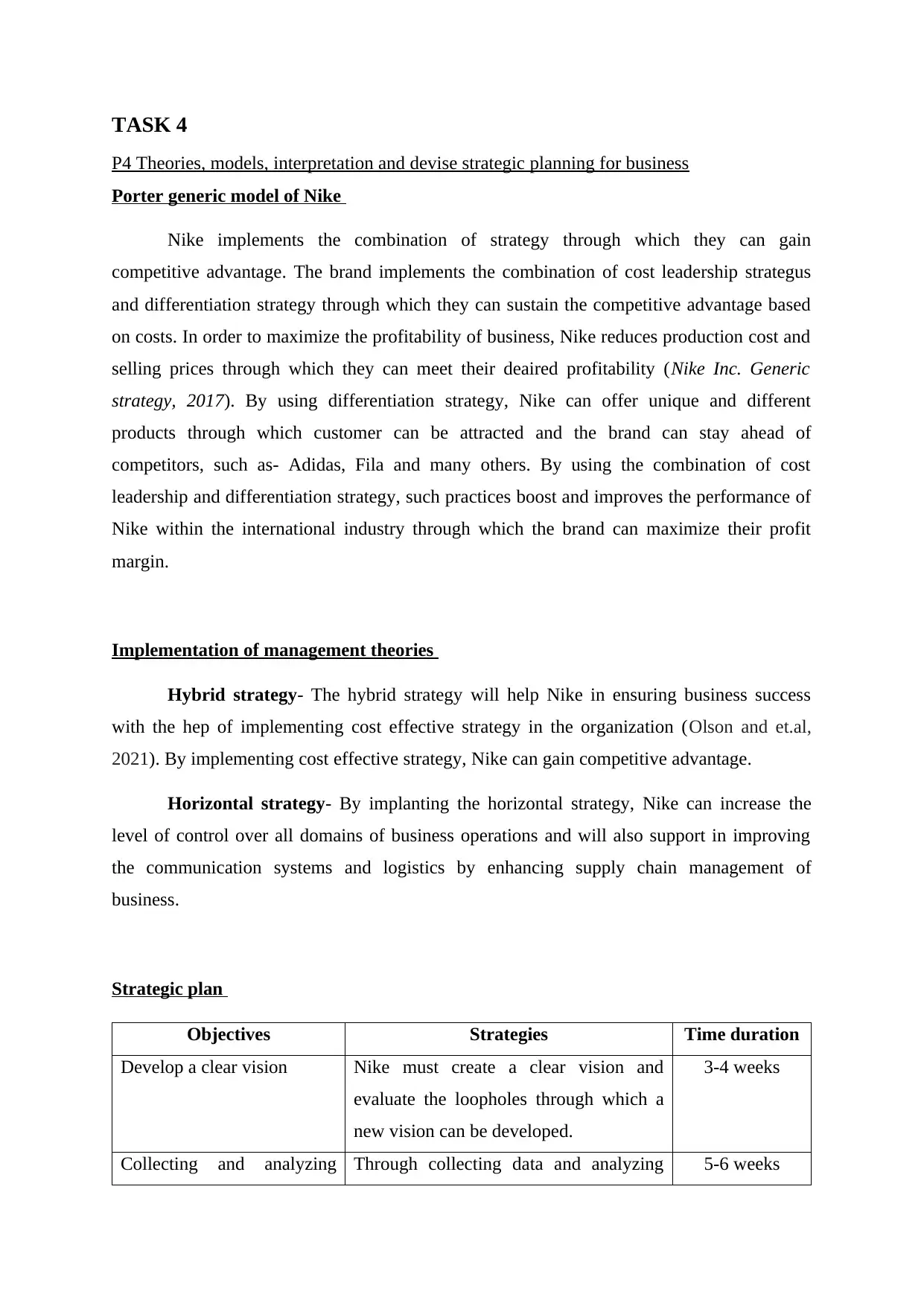
TASK 4
P4 Theories, models, interpretation and devise strategic planning for business
Porter generic model of Nike
Nike implements the combination of strategy through which they can gain
competitive advantage. The brand implements the combination of cost leadership strategus
and differentiation strategy through which they can sustain the competitive advantage based
on costs. In order to maximize the profitability of business, Nike reduces production cost and
selling prices through which they can meet their deaired profitability (Nike Inc. Generic
strategy, 2017). By using differentiation strategy, Nike can offer unique and different
products through which customer can be attracted and the brand can stay ahead of
competitors, such as- Adidas, Fila and many others. By using the combination of cost
leadership and differentiation strategy, such practices boost and improves the performance of
Nike within the international industry through which the brand can maximize their profit
margin.
Implementation of management theories
Hybrid strategy- The hybrid strategy will help Nike in ensuring business success
with the hep of implementing cost effective strategy in the organization (Olson and et.al,
2021). By implementing cost effective strategy, Nike can gain competitive advantage.
Horizontal strategy- By implanting the horizontal strategy, Nike can increase the
level of control over all domains of business operations and will also support in improving
the communication systems and logistics by enhancing supply chain management of
business.
Strategic plan
Objectives Strategies Time duration
Develop a clear vision Nike must create a clear vision and
evaluate the loopholes through which a
new vision can be developed.
3-4 weeks
Collecting and analyzing Through collecting data and analyzing 5-6 weeks
P4 Theories, models, interpretation and devise strategic planning for business
Porter generic model of Nike
Nike implements the combination of strategy through which they can gain
competitive advantage. The brand implements the combination of cost leadership strategus
and differentiation strategy through which they can sustain the competitive advantage based
on costs. In order to maximize the profitability of business, Nike reduces production cost and
selling prices through which they can meet their deaired profitability (Nike Inc. Generic
strategy, 2017). By using differentiation strategy, Nike can offer unique and different
products through which customer can be attracted and the brand can stay ahead of
competitors, such as- Adidas, Fila and many others. By using the combination of cost
leadership and differentiation strategy, such practices boost and improves the performance of
Nike within the international industry through which the brand can maximize their profit
margin.
Implementation of management theories
Hybrid strategy- The hybrid strategy will help Nike in ensuring business success
with the hep of implementing cost effective strategy in the organization (Olson and et.al,
2021). By implementing cost effective strategy, Nike can gain competitive advantage.
Horizontal strategy- By implanting the horizontal strategy, Nike can increase the
level of control over all domains of business operations and will also support in improving
the communication systems and logistics by enhancing supply chain management of
business.
Strategic plan
Objectives Strategies Time duration
Develop a clear vision Nike must create a clear vision and
evaluate the loopholes through which a
new vision can be developed.
3-4 weeks
Collecting and analyzing Through collecting data and analyzing 5-6 weeks
You're viewing a preview
Unlock full access by subscribing today!
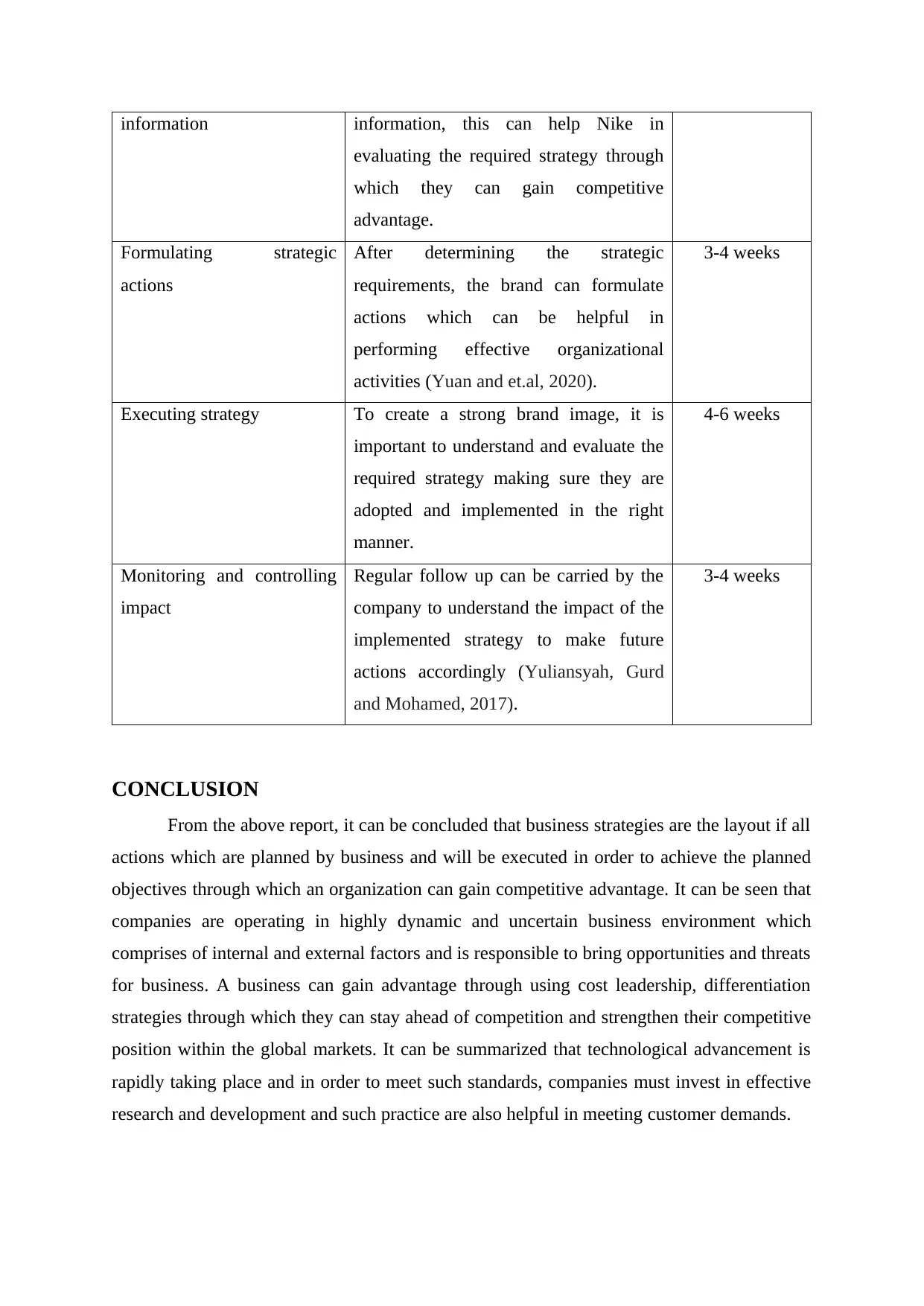
information information, this can help Nike in
evaluating the required strategy through
which they can gain competitive
advantage.
Formulating strategic
actions
After determining the strategic
requirements, the brand can formulate
actions which can be helpful in
performing effective organizational
activities (Yuan and et.al, 2020).
3-4 weeks
Executing strategy To create a strong brand image, it is
important to understand and evaluate the
required strategy making sure they are
adopted and implemented in the right
manner.
4-6 weeks
Monitoring and controlling
impact
Regular follow up can be carried by the
company to understand the impact of the
implemented strategy to make future
actions accordingly (Yuliansyah, Gurd
and Mohamed, 2017).
3-4 weeks
CONCLUSION
From the above report, it can be concluded that business strategies are the layout if all
actions which are planned by business and will be executed in order to achieve the planned
objectives through which an organization can gain competitive advantage. It can be seen that
companies are operating in highly dynamic and uncertain business environment which
comprises of internal and external factors and is responsible to bring opportunities and threats
for business. A business can gain advantage through using cost leadership, differentiation
strategies through which they can stay ahead of competition and strengthen their competitive
position within the global markets. It can be summarized that technological advancement is
rapidly taking place and in order to meet such standards, companies must invest in effective
research and development and such practice are also helpful in meeting customer demands.
evaluating the required strategy through
which they can gain competitive
advantage.
Formulating strategic
actions
After determining the strategic
requirements, the brand can formulate
actions which can be helpful in
performing effective organizational
activities (Yuan and et.al, 2020).
3-4 weeks
Executing strategy To create a strong brand image, it is
important to understand and evaluate the
required strategy making sure they are
adopted and implemented in the right
manner.
4-6 weeks
Monitoring and controlling
impact
Regular follow up can be carried by the
company to understand the impact of the
implemented strategy to make future
actions accordingly (Yuliansyah, Gurd
and Mohamed, 2017).
3-4 weeks
CONCLUSION
From the above report, it can be concluded that business strategies are the layout if all
actions which are planned by business and will be executed in order to achieve the planned
objectives through which an organization can gain competitive advantage. It can be seen that
companies are operating in highly dynamic and uncertain business environment which
comprises of internal and external factors and is responsible to bring opportunities and threats
for business. A business can gain advantage through using cost leadership, differentiation
strategies through which they can stay ahead of competition and strengthen their competitive
position within the global markets. It can be summarized that technological advancement is
rapidly taking place and in order to meet such standards, companies must invest in effective
research and development and such practice are also helpful in meeting customer demands.
Paraphrase This Document
Need a fresh take? Get an instant paraphrase of this document with our AI Paraphraser
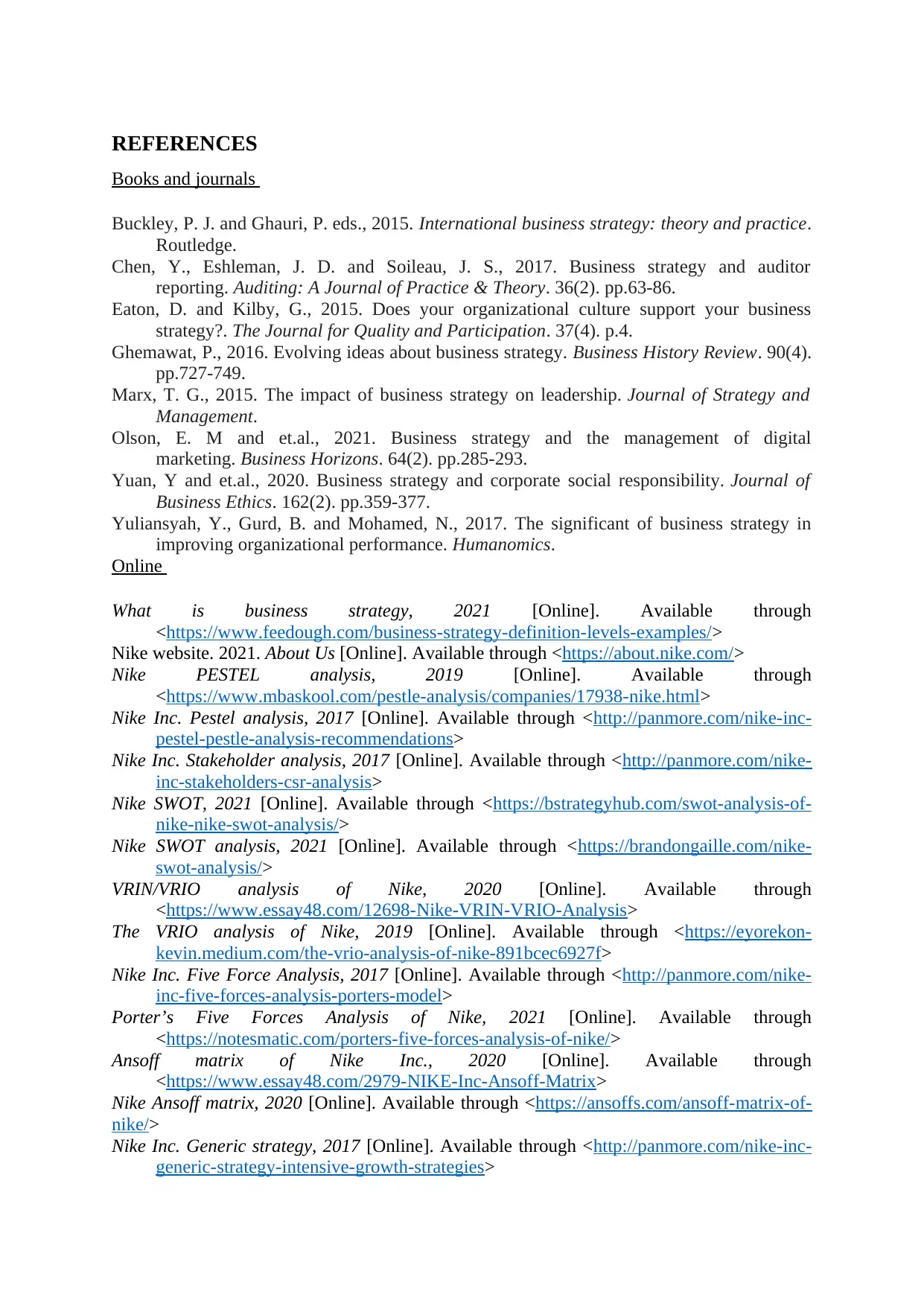
REFERENCES
Books and journals
Buckley, P. J. and Ghauri, P. eds., 2015. International business strategy: theory and practice.
Routledge.
Chen, Y., Eshleman, J. D. and Soileau, J. S., 2017. Business strategy and auditor
reporting. Auditing: A Journal of Practice & Theory. 36(2). pp.63-86.
Eaton, D. and Kilby, G., 2015. Does your organizational culture support your business
strategy?. The Journal for Quality and Participation. 37(4). p.4.
Ghemawat, P., 2016. Evolving ideas about business strategy. Business History Review. 90(4).
pp.727-749.
Marx, T. G., 2015. The impact of business strategy on leadership. Journal of Strategy and
Management.
Olson, E. M and et.al., 2021. Business strategy and the management of digital
marketing. Business Horizons. 64(2). pp.285-293.
Yuan, Y and et.al., 2020. Business strategy and corporate social responsibility. Journal of
Business Ethics. 162(2). pp.359-377.
Yuliansyah, Y., Gurd, B. and Mohamed, N., 2017. The significant of business strategy in
improving organizational performance. Humanomics.
Online
What is business strategy, 2021 [Online]. Available through
<https://www.feedough.com/business-strategy-definition-levels-examples/>
Nike website. 2021. About Us [Online]. Available through <https://about.nike.com/>
Nike PESTEL analysis, 2019 [Online]. Available through
<https://www.mbaskool.com/pestle-analysis/companies/17938-nike.html>
Nike Inc. Pestel analysis, 2017 [Online]. Available through <http://panmore.com/nike-inc-
pestel-pestle-analysis-recommendations>
Nike Inc. Stakeholder analysis, 2017 [Online]. Available through <http://panmore.com/nike-
inc-stakeholders-csr-analysis>
Nike SWOT, 2021 [Online]. Available through <https://bstrategyhub.com/swot-analysis-of-
nike-nike-swot-analysis/>
Nike SWOT analysis, 2021 [Online]. Available through <https://brandongaille.com/nike-
swot-analysis/>
VRIN/VRIO analysis of Nike, 2020 [Online]. Available through
<https://www.essay48.com/12698-Nike-VRIN-VRIO-Analysis>
The VRIO analysis of Nike, 2019 [Online]. Available through <https://eyorekon-
kevin.medium.com/the-vrio-analysis-of-nike-891bcec6927f>
Nike Inc. Five Force Analysis, 2017 [Online]. Available through <http://panmore.com/nike-
inc-five-forces-analysis-porters-model>
Porter’s Five Forces Analysis of Nike, 2021 [Online]. Available through
<https://notesmatic.com/porters-five-forces-analysis-of-nike/>
Ansoff matrix of Nike Inc., 2020 [Online]. Available through
<https://www.essay48.com/2979-NIKE-Inc-Ansoff-Matrix>
Nike Ansoff matrix, 2020 [Online]. Available through <https://ansoffs.com/ansoff-matrix-of-
nike/>
Nike Inc. Generic strategy, 2017 [Online]. Available through <http://panmore.com/nike-inc-
generic-strategy-intensive-growth-strategies>
Books and journals
Buckley, P. J. and Ghauri, P. eds., 2015. International business strategy: theory and practice.
Routledge.
Chen, Y., Eshleman, J. D. and Soileau, J. S., 2017. Business strategy and auditor
reporting. Auditing: A Journal of Practice & Theory. 36(2). pp.63-86.
Eaton, D. and Kilby, G., 2015. Does your organizational culture support your business
strategy?. The Journal for Quality and Participation. 37(4). p.4.
Ghemawat, P., 2016. Evolving ideas about business strategy. Business History Review. 90(4).
pp.727-749.
Marx, T. G., 2015. The impact of business strategy on leadership. Journal of Strategy and
Management.
Olson, E. M and et.al., 2021. Business strategy and the management of digital
marketing. Business Horizons. 64(2). pp.285-293.
Yuan, Y and et.al., 2020. Business strategy and corporate social responsibility. Journal of
Business Ethics. 162(2). pp.359-377.
Yuliansyah, Y., Gurd, B. and Mohamed, N., 2017. The significant of business strategy in
improving organizational performance. Humanomics.
Online
What is business strategy, 2021 [Online]. Available through
<https://www.feedough.com/business-strategy-definition-levels-examples/>
Nike website. 2021. About Us [Online]. Available through <https://about.nike.com/>
Nike PESTEL analysis, 2019 [Online]. Available through
<https://www.mbaskool.com/pestle-analysis/companies/17938-nike.html>
Nike Inc. Pestel analysis, 2017 [Online]. Available through <http://panmore.com/nike-inc-
pestel-pestle-analysis-recommendations>
Nike Inc. Stakeholder analysis, 2017 [Online]. Available through <http://panmore.com/nike-
inc-stakeholders-csr-analysis>
Nike SWOT, 2021 [Online]. Available through <https://bstrategyhub.com/swot-analysis-of-
nike-nike-swot-analysis/>
Nike SWOT analysis, 2021 [Online]. Available through <https://brandongaille.com/nike-
swot-analysis/>
VRIN/VRIO analysis of Nike, 2020 [Online]. Available through
<https://www.essay48.com/12698-Nike-VRIN-VRIO-Analysis>
The VRIO analysis of Nike, 2019 [Online]. Available through <https://eyorekon-
kevin.medium.com/the-vrio-analysis-of-nike-891bcec6927f>
Nike Inc. Five Force Analysis, 2017 [Online]. Available through <http://panmore.com/nike-
inc-five-forces-analysis-porters-model>
Porter’s Five Forces Analysis of Nike, 2021 [Online]. Available through
<https://notesmatic.com/porters-five-forces-analysis-of-nike/>
Ansoff matrix of Nike Inc., 2020 [Online]. Available through
<https://www.essay48.com/2979-NIKE-Inc-Ansoff-Matrix>
Nike Ansoff matrix, 2020 [Online]. Available through <https://ansoffs.com/ansoff-matrix-of-
nike/>
Nike Inc. Generic strategy, 2017 [Online]. Available through <http://panmore.com/nike-inc-
generic-strategy-intensive-growth-strategies>

You're viewing a preview
Unlock full access by subscribing today!
1 out of 15
Related Documents
Your All-in-One AI-Powered Toolkit for Academic Success.
+13062052269
info@desklib.com
Available 24*7 on WhatsApp / Email
![[object Object]](/_next/static/media/star-bottom.7253800d.svg)
Unlock your academic potential
© 2024 | Zucol Services PVT LTD | All rights reserved.




